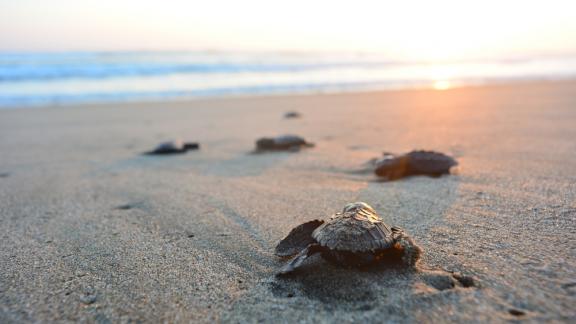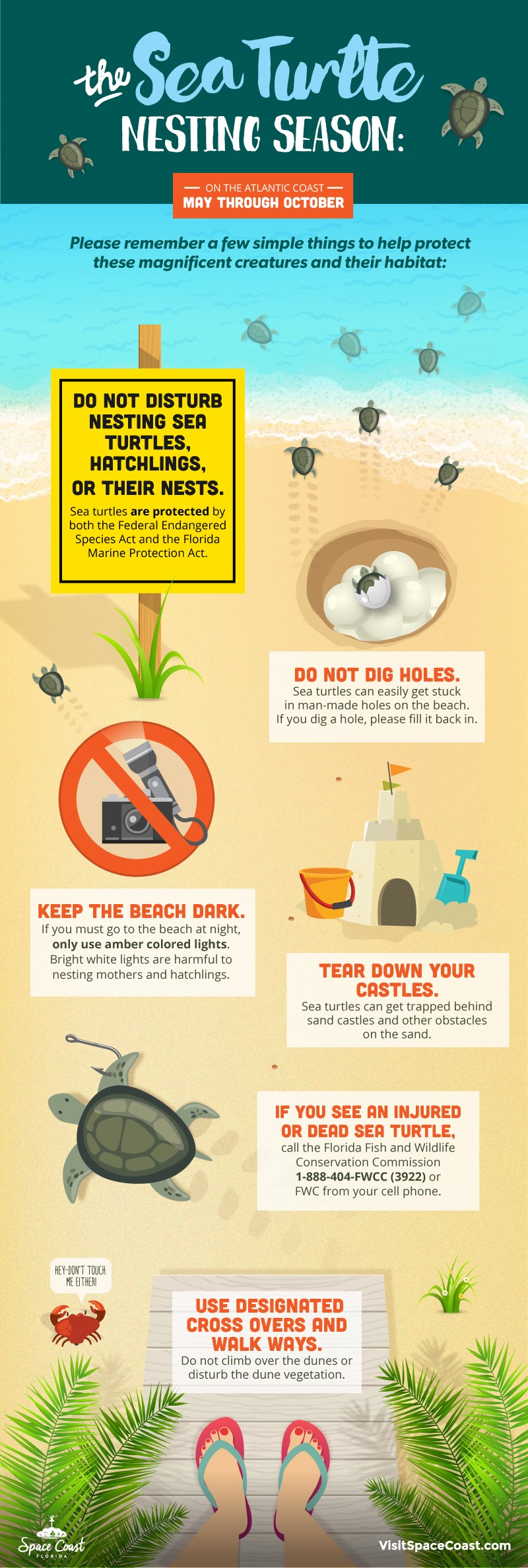Florida’s Space Coast is a sea turtle’s paradise, with 72 miles of coastline, there’s plenty of space for these incredible marine animals to make their nests and lay clutches upon clutches of eggs. Sea Turtle Season is a particularly exciting but sensitive time on the Space Coast. In 2019 more than 30,000 nests were counted on the beaches of Brevard County alone! From the northern-most reaches of the Canaveral National Seashore to the Beaches of the Sebastian Inlet, visitors and residents must be on high alert to protect these turtles and their nests. Here are 5 things you need to know about Sea Turtle Season.
1) When and What is Sea Turtle Season?
Sea turtle season starts on May 1 and goes through November 15. It is a time where sea turtles nest and hatch and what an extraordinary process it is. From egg to hatchling, a sea turtle must endure the delicate process of development in order to make its way from land to sea. Each species has a different egg incubation period (the time it takes the turtle to hatch), but generally, it can take anywhere between 45-75 days. And an interesting fact is that it’s the temperature that determines if the hatchlings are male or female. Warmer temperatures will result in female turtles, whereas colder temperatures produce males.
2) Where can You Participate in a Sea Turtle Walk on the Space Coast?
There are a few ways to sign up to take a Turtle Walk on the Space Coast. The 72 miles of coastline mean that there are plenty of opportunities for you to witness a nesting female! You can either call or reserve a spot online at one of these organizations. When you call to make your reservations, inquire about COVID-19 considerations.
● Friends of Sebastian Inlet State Park – Reservations required
● Archie Carr National Wildlife Refuge – Reservations required
● Sea Turtle Preservation Society – Reservations required
● Merritt Island National Wildlife Refuge – Reservations required
● Stella Maris Environmental Research – Reservations required
3) How do You Keep the Sea Turtles Safe?
To ensure the safety of the sea turtles, there are specific measures you can take whether you see one on your own or while you are on a turtle walk.
● Do not touch or disturb nesting sea turtles, hatchlings, or their nests.
● If you dig or see a hole in the sand, refill them before you leave the beach.
● Tear down sandcastles, but take a picture of it first to remember your masterpiece.
● Do not walk on the sand dunes. Use designated crossovers and walkways and mind the signs
● Don’t litter!!! Dispose of trash properly including cigarette butts.
● Only use amber-colored lights when walking the beach at night. Bright white lights are harmful to sea turtles. No photographing or videoing these creatures.
● If you see a sea turtle, whether injured or dead, contact the Sea Turtle Preservation Society at (321) 206-0646, a 24/7 hotline
4) What Types of Sea Turtles Make the Space Coast Home?
The Loggerhead, Leatherback, and Green Turtles call the Space Coast home. Each species has its own unique features. The Loggerhead is the largest of the hard-shell turtles and is named for its massive head and strong jaws. Its shell is heart-shaped with a reddish-brown color. It is the most common turtle in Florida. The Green Turtle has a wide, smooth shell and is named “Green” because of its body fat, not its shell, which is browner in color. Green turtles have a non-retractable head that is pretty small in comparison to its large shell and can be upwards of 700 pounds. The Leatherback is the largest of all sea turtles at up to 7 feet long and in excess of 1,000 pounds. Leatherbacks take on on the longest migration distances between breeding and feeding at around 3,700 miles each way. The Leatherback is considered a soft-shell turtle because its inky-blue shell is a bit flexible and rubbery to the touch. And every so often, Florida’s Space Coast is graced with the Kemps Ridley Turtle. Kemps Ridley is some of the smallest of the sea turtles only reaching up to 2 feet and no more than 100 pounds. Its shell is hard and greenish-gray while its belly is off-white or yellow. The Green, Leatherback, and Kemps Ridley Turtles are considered endangered species.
5) Where can You get More Sea Turtle Information on the Space Coast?
The Sea Turtle Preservation Society (STPS) located in Indialantic has a wealth of information about the sea turtles that make the Space Coast their nesting home. STPS hosts a wide range of events, exhibits, presentations, and, of course, turtle walks in order to educate the public. This is a great way to incorporate a bit of education into your vacation without it feeling like “school.” Plus, you’ll want to stop inside the store and grab a few take-home souvenirs. Proceeds allow STPS to continue their incredible work to ensure the safety and preservation of these beautiful sea turtles.
Keep learning about this season by following the Brevard Zoo, The Sea Turtle Preservation Society, and The Brevard County Barrier Island Sanctuary on Facebook. And when you can start making plans to visit the Space Coast, make sure you schedule a turtle walk on one of our many beaches.
Check out the Space Coast Vacation Planner or the links below to help you discover more ways to relax on the Space Coast.

